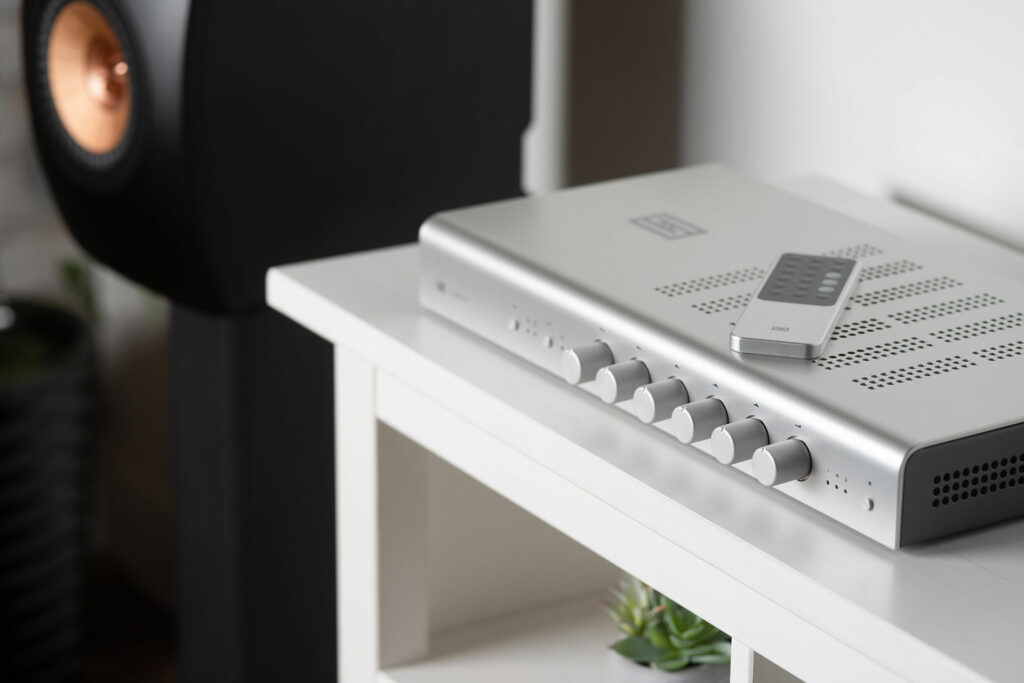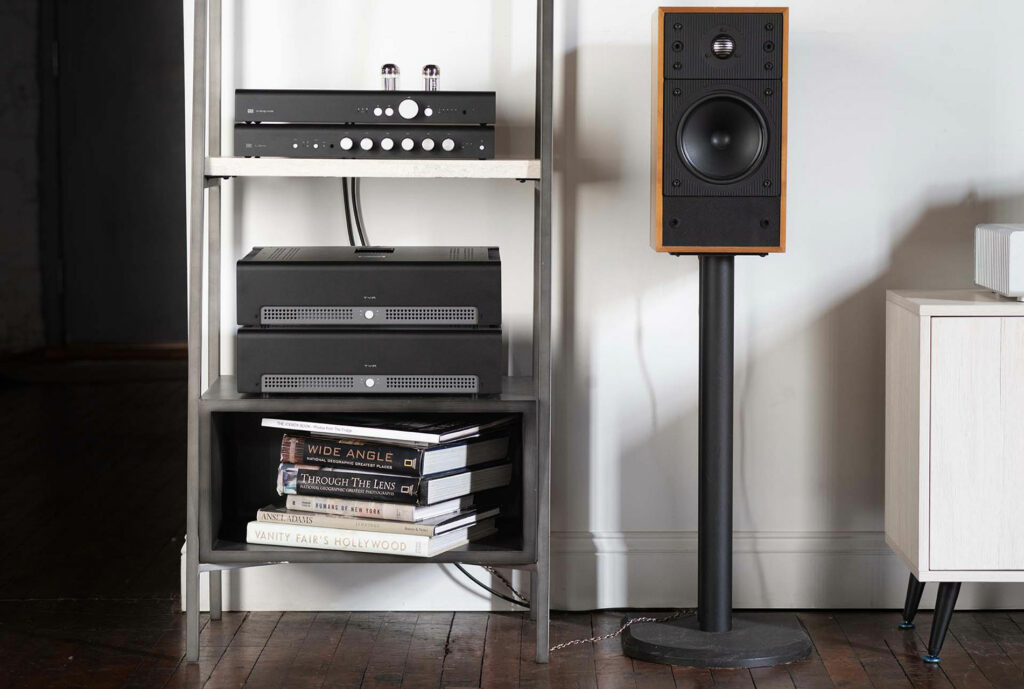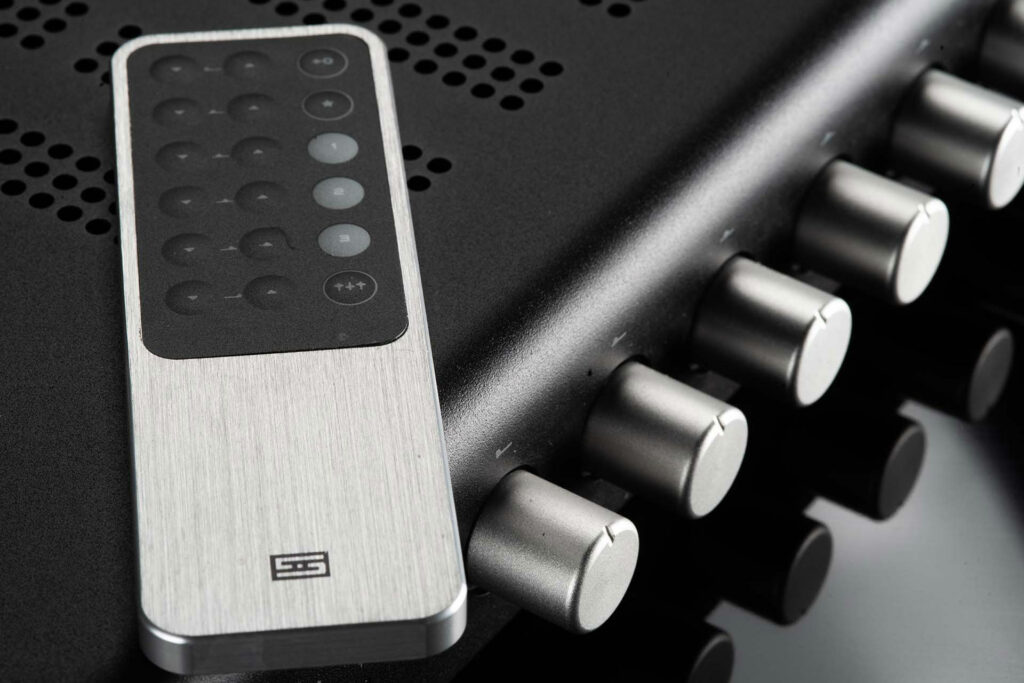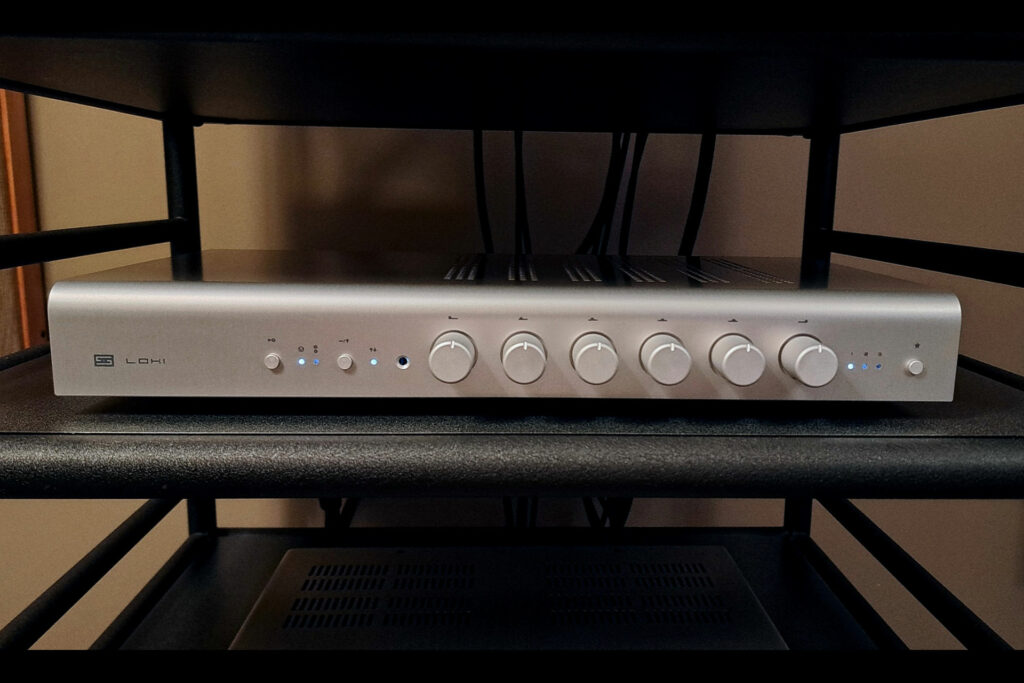The Schiit Loki Max equalizer is a unique item in today’s audio market: an analog broadband EQ with excellent sonics that can complement even very revealing audio systems. Schiit’s most expensive equalizer at $1,499, the Loki Max offers two selectable stereo inputs (one single-ended RCA; one balanced XLR); RCA and XLR outputs; a bypass setting for the equalization circuitry; three user presets for favorite settings; and a full-function remote control.

What Makes the Schiit Loki Max Equalizer Special?
- The Schiit Loki Max has six well-chosen equalization bands, at 20 Hz, 120 Hz, 400 Hz, 2 kHz, 6 kHz, and 16 kHz, making it easy to address problem areas in recordings. Does the sound lack warmth? Increase 400 Hz. Are vocals too in-your-face? Cut 2 kHz. Are the cymbals and snares tizzy? Cut 6 kHz and/or 16 kHz. After a little experimenting, it becomes intuitive as well as very personal.
- Schiit uses motorized equalization switches with relays instead of potentiometers, as the later can get noisy with age. This is a high-quality feature that adds precision and repeatability. And when you use the remote, the knobs still turn, which is neat to watch.
- Equalization step-size varies, with the steps closest to flat making very small changes, especially in midrange bands, and subsequent steps (each band has 31) making larger changes. This allows very subtle adjustments, as well as bigger ones as you desire.
- The equalization bands are wide (sometimes called low Q), which avoids unnatural effects when in use.
- The very low noise and distortion is remarkable for an equalizer and puts the Schiit Loki Max into a very small group of top-end EQs. Let’s face it: when you’re listening into the music, even small amounts of noise or distortion can take away from the experience
- Three presets let you save favorite settings and adjust frequency response from your seat.

Why Should You Care About the Schiit Loki Max Equalizer?
Those who listen regularly to recorded music soon realize that each specific recording has its own sound or voicing. This becomes more and more noticeable as your audio system improves. Many recordings sound good—and a few sound great—but others might have too much or too little bass. The sound might lack warmth or have irritating violin, banjo, or harpsichord sound, and judicious use of EQ can help smooth over those audio bumps. A broadband equalizer such as the Schiit Loki Max is an ideal tool for touching up such issues, despite outdated audiophile stereotypes that pooh-pooh EQ in audiophile systems. Every recording may not wind up perfect, but having more enjoyment from poorer recordings is the goal.
The age-old audiophile stereotype that EQ is bad because it inserts phase shift badly needs to be ignored. Think about any mainstream record you love from your music collection (or streaming). If it was recorded on a 128-channel console, there are 128 elements that could (and likely do) have EQ applied. The house speakers are EQed. So are the house subs. So are the nearfield speakers often placed on top of the console. Oh, and the mastering engineer uses EQ on the stereo bus, too. Saying it’s not OK to use EQ in your audiophile system is just a silly stereotype—and wrong.
Some Things You Might Not Like About the Schiit Loki Max Equalizer
- Schiit products have a consistent visual aesthetic that’s not always to everyone’s taste. Knob pointers on the Loki Max are all but invisible. Function labels on the chassis and remote are tiny, low-contrast dots and squiggles. The visually challenged will have trouble at first, but reading the manual helps. After 15 minutes of using the Schiit Loki Max, you’ll remember what the buttons do, so this isn’t too much of a knock on the product.
- The presets are great, but the interface has its shortcomings. You can’t modify preset A and save to preset B, because to save to B, you have to switch to it first, which discards the settings you’ve just made. And because the individual bands don’t have reset buttons, it can be difficult to program a preset from a known baseline.
- The Schiit Loki Max uses inductors, a design element found in high-quality equalizers but one that potentially can pick up hum. To avoid this, the unit shouldn’t be stacked or put next to AC wiring. Schiit recommends placing it on a ventilated shelf by itself.
Listening to the Schiit Loki Max Equalizer…
Not every meal benefits from more salt, and not every recording will benefit from EQ. When a track sounds great as released, the best equalizers—the most transparent ones—can be set flat and won’t alter the sound whatsoever. I started my listening session with a group of tracks (in various genres) that I use regularly to show off my audio system. Would the Schiit Loki Max let the magic shine through unchanged? I played each track with the Loki Max set to flat, then with it in bypass mode, and finally I toggled the bypass control repeatedly while listening for a difference.
On the (96/24 Qobuz) acoustic version of Sam Smith’s “Love Me More”,Smith’s voice was natural and emotional, and as usually happens, I found his ballad of personal struggle deeply touching. On this and all my other demo tracks, the sound and emotion came through unchanged, with nothing even hinting at the added device in the signal chain. I concluded that the Schiit Loki Max is one of the great equalizers, one of the transparent ones.
To test again for low-level noise, I turned my preamp’s volume to 12 dB beyond my loudest listening. With no music playing and my ears right at the speakers, I heard absolutely no sound.
Next, I played music I love but that could use EQ. The Beach Boys classic “In My Room” from Surfer Girl (192/24 Qobuz stereo version) shows Brian Wilson moving beyond surf, cars, and girls into a more introspective mood. Though the music is genius, the sound seemed a little too processed in the treble, so I turned to the Loki Max. My EQ process is to pick bands I think are most likely to help, and in the treble, those are 6 kHz and 16 kHz. (The 2 kHz band is more midrange or presence range.) Then I add EQ one band at a time, one click at a time, until there’s a change for the better. If there’s no improvement, that band goes back to flat. Often, I overshoot the best setting and reduce a little, which helps get the EQ just right. Then, it’s on to the next candidate EQ band.
The process may sound involved, but in practice, it takes only a few seconds. For “In My Room,” I wound up cutting 6 kHz and 16 kHz by about 2 steps each. This small amount of EQ was enough to make the voices more natural and increase my connection with the song.
Leonard Bernstein was a conductor, composer, and educator with a colorful life. He also was among the most sympathetic conductors of Joseph Haydn’s music. His recording of Symphony 94 (“Surprise”) with the NY Philharmonic (44.1/16 CD rip) is lively and warmhearted. However, the bass can sound muddy and the violins a bit steely. I found that EQ at 20 Hz was not helpful, but cutting 120 Hz (the midbass or power range) made an improvement. I wound up reducing 120 Hz to clear out the mud, then reducing 6 kHz and 16 kHz to make the violins sweeter. It was a pleasure to hear this old Columbia recording come into focus sonically with a little EQ.
Does the Schiit Loki Max Equalizer Have Any Resale Value?
Yes, it certainly does. Schiit is highly regarded for value and sound quality, and their used products seem to sell without much difficulty. For the Schiit Loki Max, I found only expired listings on the used market, most with prices around $1,200. That is 80 percent of new—less depreciation than most used audio components.

What is the Competition for the Schiit Loki Max Equalizer?
Broadband equalizers aren’t easy to find these days, especially in the audiophile world. The only current competitors I know of are Schiit’s less expensive models, the Schiit Loki Mini ($149 – buy at Amazon) and Lokius ($299). The Loki Mini has four bands, one RCA input, and one RCA output. The Lokius has six bands and selectable RCA and XLR inputs and outputs. Neither model has the remote and presets of the Loki Max, nor its more advanced circuitry.Either could be fine as a lower-cost broadband equalizer to start with and potentially trade up from.
The Cello Palette Preamp ($6,500 when it was new) was highly regarded but hasn’t been made for about 25 years. It’s similar to the Schiit Loki Max in having six broad bands; it adds a volume control, more inputs, and a tape loop, but the old Cello classic lacks remote control and any thought of presets. A used Palette Preamp can sell for $6,000 or more despite its age. Though I loved the one I owned, it was much noisier than the Schiit Loki Max.
There are many 1/3-octave graphic equalizers on the market, especially from the pro audio market segment, but with 31 narrow bands rather than six wide ones, they are cumbersome to use while listening. The ones I’ve auditioned don’t sound as good as the Schiit Loki Max.
The Weiss EQ1 Mk2 ($6,700) is a seven-band digital parametric equalizer widely used in mastering studios. It has clean sound, a fantastic display that graphs the selected equalization, and presets, but no remote, and only a single AES3 digital input and output, which makes it potentially a poor fit for many home audio systems. It is designed for a different task and in my experience can be a bit clumsy for adjustments while listening, but it’s one of few products in the sonic league of the Schiit Loki Max.
Roon (about $150/year subscription) is multiplatform music software that offers digital equalization among its many features. I’ve found its equalization quite clean but somewhat complex to set up. Roon’s output is muted for a few seconds when you change equalization settings, which as a listener I find somewhat distracting. Roon equalization is also applied only to digital files or streaming services played through Roon, not to music from a CD player or turntable.

Final Thoughts on the Schiit Loki Max Equalizer
For decades, some enthusiasts have argued that equalizers (including tone controls) degrade the sound, and in some cases, early ones did. But it’s a new day. The Schiit Loki Max is as colorless as any EQ I’ve heard. It does not degrade the sound in any meaningful way.
Some also have argued that home equalization changes the sound the artist or mastering engineer intended. Well, mastering engineers are human and you may not agree with every decision they make. Also consider: do you have the same playback gear as the mastering engineer? The same speakers? The same acoustically treated room? Do you listen at the same level? Unless you do, you are not completely hearing what the engineer was hearing. So why not touch up the sound when necessary to make it more natural to your ears?
If you need to address big problems with listening-room acoustics, I would not recommend the Schiit Loki Max. Instead, consider a preamp with a room-correction feature, such as the Anthem STR Preamp, NAD M66, Trinnov Amethyst, or Classé Delta Pre (read the reviews). Once you have room correction set up, you might consider getting a Schiit Loki Max later for touching up specific recordings.
If your main goal is to make imperfect recordings sound more natural, a broadband equalizer is the tool for you. The Schiit Loki Max meets or exceeds the performance of the $6,500 Cello of old for less than 25 percent of its historical (or current used market) price. If you are someone who wants the best sound each recording can deliver, and you don’t mind twisting dials now and then to get it, the Schiit Loki Max will be a great addition to your audio system. I enjoy it so much that I bought one myself. It is a lot of fun, and I recommend it to anyone who wants to take more control over what they hear—no matter how expensive their system.




Nice thorough review. Have you tried charter oak studio equalizer? I think the max offer ease of use plus top not components, thus it’s superiority to other rivals.
That is a new one to me but we will look into it.
Thanks for the lead.
I JUST got finished copy back for a Jay’s Audio CD Transport that I learned about the same way. Always be learning (and closing), I guess!!! 🙂
Eran, Thanks for the comment. I’ve not had a chance to try the Charter Oak PEQ-1 equalizer, and in searching the Web, I do see many positive comments. However, it’s not clear if the model is in current production or even if the company is still in business. The Web address leads to a firm whose main business is streaming music.
Well, I have also gave it a look, googled, indeed the company’s current profile of activity is vague… yet cello is not in production too, so it’s worth mentioning the charter oak peq-1 just for the sake of audio history knowledge. It seems to be a unique product, interesting enough to explor. It is still offered via that site zmong few others https://www.soundpure.com/p/charter-oak-peq1-stereo-eq/2415